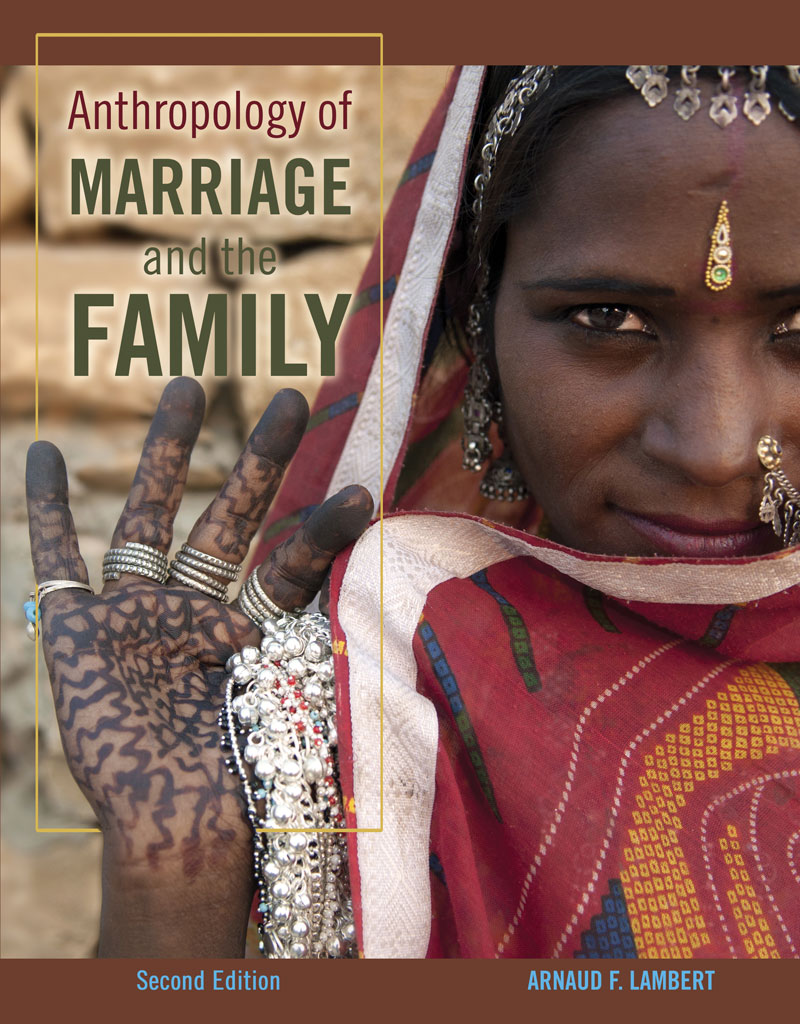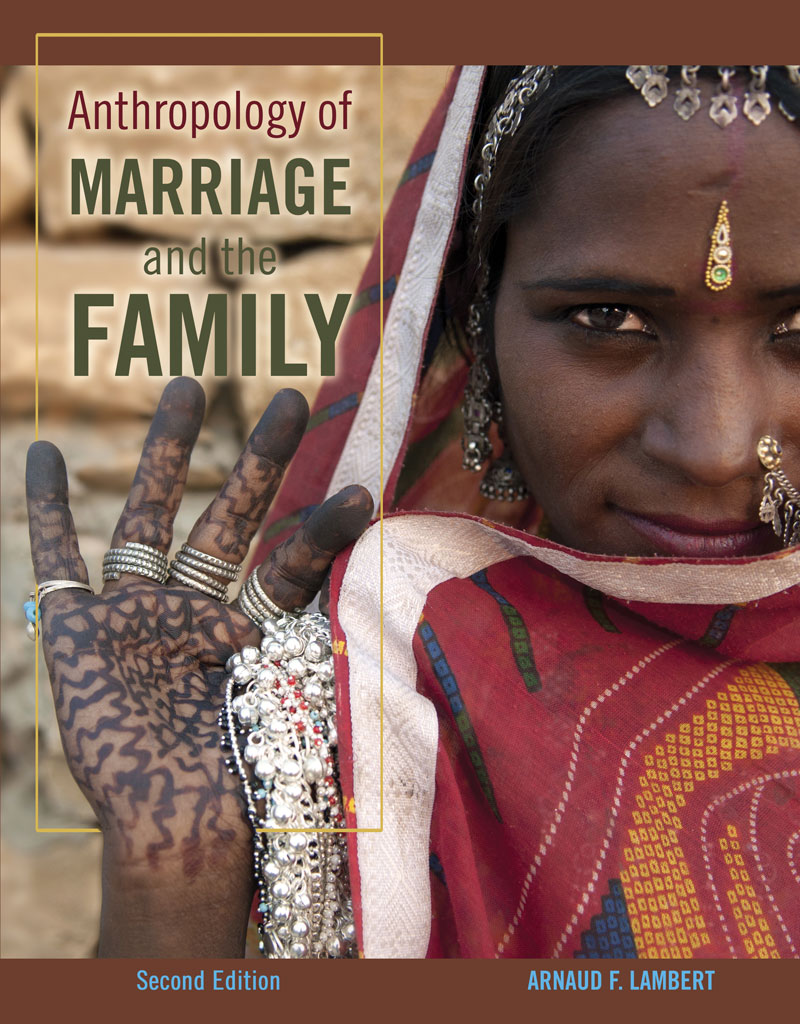Anthropology of Marriage and the Family
Author(s): Arnaud Lambert
Edition: 2
Copyright: 2017
Pages: 356
About the Author
Preface: About This Book
New Features of The Second Edition
SECTION I The Cross-Cultural Study of Marriage, Family, and Kinship
Chapter 1: Introduction
What are some common ways in which people understand marriage and the family?
How can anthropology help us understand marriage and the family?
Why study marriage, family, and kinship from an anthropological perspective?
Chapter 2: Defining Families: Problems and Prospects
What is the Family?
How are families structured?
What are some of the basic things we consider families to be all about?
Does biology or society determine the structure of families and the nature of the relationships among family members?
Chapter 3: Kinship, Relatedness, and the Structure of Families
What is Kinship?
How do anthropologists study kinship?
How do people determine their relationship to other members of their family?
What are the consequences of living in societies with different ways of reckoning kinship?
How do people in different societies create a sense of “relatedness” to others?
Can non-human beings be a part of families?
Chapter 4: Courtship and Marriage
Is there a way of defining marriage which can be applied to all societies?
How are spouses selected? Courtship and other pre-nuptial rituals
What are marriage transactions?
How are marriage rituals organized around the world?
How do marriages end in different societies around the world?
What is Lévi-Strauss’s ‘Alliance Theory’? An early attempt at theorizing marriage and kinship
Chapter 5: The Origin of the Family: Myths, Metaphors, and Mistakes
How did early scholars portray the origin of the family?
What kinds of information can be used to reconstruct early families?
Do human families share any traits with non-human primate social groups?
SECTION II Family Life across the Globe: Patterns and Particularities
Chapter 6 Family Life in Foraging Societies
What cultural features are characteristic of foraging societies?
How are families in foraging societies organized?
How are kinship ties constructed in foraging societies?
How are marriages and sexuality regulated in foraging societies?
How are children socialized in the context of foraging families?
Chapter 7 The Family Systems of Sub-Saharan Africa
How have sub-Saharan societies developed in relation to the climates and environments of Africa?
How are family ties linked to the acquisition of property, power, and prestige?
Why is the regulation of sexuality an important consideration in sub-Saharan societies?
How are family groups and extra-familial associations responsible for childhood socialization?
Chapter 8: The Nature of Oceanic Families
How do families in Polynesia and Micronesia differ?
In what ways was sexuality linked to marriage and family prestige in Polynesia?
How does power and prestige impact Melanesian family organization?
Chapter 9: Native North American Social Organization
What is the best way to compare Native North American family systems and social organization?
How were Native American families organized in aboriginal times?
How were children socialized in aboriginal times?
Chapter 10: Family and Sociability in Amazonia
What cultural features characterize Amazonian societies?
What features characterize Amazonian family systems?
How does sociability affect family relationships in Amazonia?
Chapter 11: Continuity and Change in the Family Systems of Mesoamerica and the Andes
What family patterns were prevalent in pre-Hispanic Mesoamerica and the Andes?
What features characterize the family systems of modern Mesoamerica?
What features characterize the family systems in modern Andean societies?
How are families embedded in larger communities in Mesoamerica and the Andes?
SECTION III Confronting Stereotypes about Global Family Structures
Chapter 12: Asian Family Systems in Myth and Reality
What are some common stereotypes about the family systems of Asia
What features characterize the complex societies of Asia
What is the jural definition of the family?
How are families configured throughout Asia?
Chapter 13: Middle Eastern Family Systems in Myth and Reality
What are some common stereotypes about Middle Eastern family systems?
What are some of the features of the jural family in the Middle East?
How do Middle Eastern families vary from one society to another?
Chapter 14: Euro-American Family Systems in Myth and Reality
What are some common stereotypes about the family systems of Europe and North America?
How are these stereotypes related to jural definitions of the family in Europe and North America?
How are family systems in Europe and North America different from these stereotypes?
Appendix
Glossary
Bibliography
About the Author
Preface: About This Book
New Features of The Second Edition
SECTION I The Cross-Cultural Study of Marriage, Family, and Kinship
Chapter 1: Introduction
What are some common ways in which people understand marriage and the family?
How can anthropology help us understand marriage and the family?
Why study marriage, family, and kinship from an anthropological perspective?
Chapter 2: Defining Families: Problems and Prospects
What is the Family?
How are families structured?
What are some of the basic things we consider families to be all about?
Does biology or society determine the structure of families and the nature of the relationships among family members?
Chapter 3: Kinship, Relatedness, and the Structure of Families
What is Kinship?
How do anthropologists study kinship?
How do people determine their relationship to other members of their family?
What are the consequences of living in societies with different ways of reckoning kinship?
How do people in different societies create a sense of “relatedness” to others?
Can non-human beings be a part of families?
Chapter 4: Courtship and Marriage
Is there a way of defining marriage which can be applied to all societies?
How are spouses selected? Courtship and other pre-nuptial rituals
What are marriage transactions?
How are marriage rituals organized around the world?
How do marriages end in different societies around the world?
What is Lévi-Strauss’s ‘Alliance Theory’? An early attempt at theorizing marriage and kinship
Chapter 5: The Origin of the Family: Myths, Metaphors, and Mistakes
How did early scholars portray the origin of the family?
What kinds of information can be used to reconstruct early families?
Do human families share any traits with non-human primate social groups?
SECTION II Family Life across the Globe: Patterns and Particularities
Chapter 6 Family Life in Foraging Societies
What cultural features are characteristic of foraging societies?
How are families in foraging societies organized?
How are kinship ties constructed in foraging societies?
How are marriages and sexuality regulated in foraging societies?
How are children socialized in the context of foraging families?
Chapter 7 The Family Systems of Sub-Saharan Africa
How have sub-Saharan societies developed in relation to the climates and environments of Africa?
How are family ties linked to the acquisition of property, power, and prestige?
Why is the regulation of sexuality an important consideration in sub-Saharan societies?
How are family groups and extra-familial associations responsible for childhood socialization?
Chapter 8: The Nature of Oceanic Families
How do families in Polynesia and Micronesia differ?
In what ways was sexuality linked to marriage and family prestige in Polynesia?
How does power and prestige impact Melanesian family organization?
Chapter 9: Native North American Social Organization
What is the best way to compare Native North American family systems and social organization?
How were Native American families organized in aboriginal times?
How were children socialized in aboriginal times?
Chapter 10: Family and Sociability in Amazonia
What cultural features characterize Amazonian societies?
What features characterize Amazonian family systems?
How does sociability affect family relationships in Amazonia?
Chapter 11: Continuity and Change in the Family Systems of Mesoamerica and the Andes
What family patterns were prevalent in pre-Hispanic Mesoamerica and the Andes?
What features characterize the family systems of modern Mesoamerica?
What features characterize the family systems in modern Andean societies?
How are families embedded in larger communities in Mesoamerica and the Andes?
SECTION III Confronting Stereotypes about Global Family Structures
Chapter 12: Asian Family Systems in Myth and Reality
What are some common stereotypes about the family systems of Asia
What features characterize the complex societies of Asia
What is the jural definition of the family?
How are families configured throughout Asia?
Chapter 13: Middle Eastern Family Systems in Myth and Reality
What are some common stereotypes about Middle Eastern family systems?
What are some of the features of the jural family in the Middle East?
How do Middle Eastern families vary from one society to another?
Chapter 14: Euro-American Family Systems in Myth and Reality
What are some common stereotypes about the family systems of Europe and North America?
How are these stereotypes related to jural definitions of the family in Europe and North America?
How are family systems in Europe and North America different from these stereotypes?
Appendix
Glossary
Bibliography

